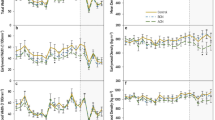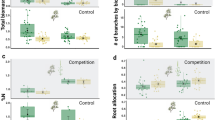Abstract
This study evaluated early mortality patterns of planted Nothofagus dombeyi (Mirb.) Blume (evergreen, shade intolerant) and Nothofagus alpina (P. et E.) Oerst. (deciduous, mid-tolerant to shade) seedlings established in scarified gaps in a Nothofagus old-growth forest in the Chilean Andes that was subjected to a shelterwood cut. Soils were scarified with heavy machinery that removed up to 40 cm of the upper horizons (e.g. it completely removed the litter layer and organic horizon, and in some cases partially the A horizon) to eliminate bamboo (Chusquea culeou E. Desv) shoots and rhizomes from the scarified areas. Two years after planting, seedlings were growing free of understory competition and mortality patterns were assessed using logistic regression models with the following predictor variables: (1) basal diameter growth in the prior year, and (2) soil strength measured as resistance to penetration. The probability of mortality of both species was highly predictable based on recent basal diameter growth. N. dombeyi seedlings appeared to be less affected by mortality, as reflected in lower sensitivity of mortality at lower growth rates compared to N. alpina. High values of resistance to penetration (>2,000 kPa) induced a higher probability of mortality in N. alpina (up to 40 % at 3,500 kPa). In contrast, N. dombeyi mortality was not significantly influenced by soil strength, which illustrates the more stress-resistant and pioneer character of this species. This study showed that recent growth rates can be used as a predictor of future mortality, but these relationships need to be calibrated for each species. In addition, our results suggest that species characteristics that relate to resource limitations, such as shade tolerance, are not adequate to understand effects of other stressors, such as soil disturbance, on mortality patterns.



Similar content being viewed by others
References
American Society of Agricultural Engineers (1990) Soil cone penetrometer. ASAE Standards S313.2:567. Am Soc Agric Eng, St. Joseph, MN
Ares A, Terry TA, Miller RE, Anderson HW, Flaming BL (2005) Ground-based forest harvesting effects on soil physical properties and Douglas-fir growth. Soil Sci Soc Am J 69:1822–1832
Berger A, Puettmann KJ, Host GE (2004) Harvesting impacts on soil and understory vegetation: the influence of season of harvest and within-site disturbance patterns on clear-cut aspen stands in Minnesota. Can J For Res 34:2159–2168
Boyden SB, Reich PB, Puettmann KJ (2009) Effects of density and ontogeny on size and growth ranks of three competing tree species. J Ecol 97:277–288
Burdett A (1990) Physiological processe in plantation establishment and the development of specifications for forest planting stock. Can J For Res 20:415–427
Burnham KP, Anderson DR (2002) Model selection and multimodel inference, 2nd edn. Springer, New York
Bustos F, González ME, Donoso PJ, Gerding V, Donoso C, Escobar B (2008) Efectos de distintas dosis de fertilizante de liberación controlada (Osmocote®) en el desarrollo de plantas de coigüe, raulí y ulmo. Bosque 29:155–161
Canham CD, Berkowitz AR, Kelly VR, Lovett GM, Ollinger SV, Schnurr JJ (1996) Biomass allocation and multiple resource limitation in tree seedlings. Can J For Res 26:1521–1530
Carter RE, Klinka K (1992) Variation in shade tolerant of Douglas fir, western hemlock, and western redcedar in coastal British Columbia. Forest Ecol Manag 55:87–105
Caspersen JP, Kobe RK (2001) Interspecific variation in sapling mortality in relation to growth and soil moisture. Oikos 92:160–168
CIREN (2001) Estudio Agrológico X Región. Descripciones de suelos, materiales y símbolos. Santiago, Chile. Centro de Investigación de Recursos Naturales. Santiago
Coopman RE, Reyes-Díaz M, Briceño VF, Corcuera LJ, Cabrera HM, Bravo LA (2008) Changes during early development in photosynthetic light acclimation capacity explain the shade to sun transition in Nothofagus nitida. Tree Physiol 28:1561–1571
Davis MA, Wrage KJ, Reich PB, Tjoelker MG, Schaeffer T, Muermann C (1999) Survival, growth, and photosynthesis of tree seedlings competing with herbaceous vegetation along a water-light-nitrogen gradient. Plant Ecol 145:341–350
de la Cruz Rot M (2005) Improving the presentation of results of logistic regression with R. ESA Bull 86:41–48
Donoso C (1981) Tipos forestales de los bosques nativos de Chile. FAO-ODEPA, Santiago
Donoso C (1993) Bosques Templados Chile y Argentina. Editorial Universitaria, Santiago
Donoso C (2006) Las especies arboreas de Chile y Argentina. Autoecología. Marisa Cuneo Ediciones, Valdivia
Donoso PJ, Soto DP (2010) Plantaciones con especies nativas en el centro-sur de Chile: experiencias, desafios y oportunidades. Revista Bosque Nativo 47:10–17
Donoso C, Deus R, Cockbaine JC, Castillo H (1986) Variaciones estructural del tipo forestal Coihue-Raulí-Tepa. Bosque 7:17–35
Donoso P, González M, Escobar B, Basso I, Otero L (1999) Viverización y plantación de Raulí, Roble y Coihue en Chile. In: Donoso C, Lara A (eds) Silvicultura de los Bosques Nativos de Chile, Ed. Universitaria, Santiago, Chile, pp 145–189
Donoso PJ, Gerding V, Uteau D, Soto DP, Thiers O, Donoso C (2007) Establecimiento y crecimiento inicial de una plantación tardía deNothofagus dombeyi en Los Andes valdivianos. Bosque 28:249–255
Donoso PJ, Muñoz AA, Thiers O, Soto DP, Donoso C (2011) Effects of aspect and type of competition on the early performance of Nothofagus dombeyi and N. nervosa in a mixed plantation in the Chilean Andes. Can J For Res 41:1075–1081
Donoso PJ, Soto DP, Coopman RE, Rodriguez-Bertos S (2013) Early performance of planted Nothofagus dombeyi and Nothofagus nervosa in response to light availability and gap size in a high-graded forest in the south-central Andes of Chile. Bosque 33:23–32
Duryea ML, Landis TD (1984) Forest nursery manual: production of bareroot seedlings. Dr. Junk Publishers, The Hage
Frazer GW, Canham CD, Lertzman KP (1999) Gap light analyzer (GLA), version 2.0: imaging software to extract canopy structure and gap light indices from true-colour fisheye photographs. Simon Fraser University, Burnaby, BC, and the Institute of Ecosystem Studies, Millbrook, NY
González ME, Veblen TT, Donoso C, Valeria L (2002) Tree regeneration responses in lowland Nothofagus– dominated forest after bamboo dieback in South Central Chile. Plant Ecol 161:59–73
Grossnickle SC (2005) Importance of root growth in overcoming planting stress. New For 30:273–294
Holste EK, Kobe RK, Vriesendorp CF (2011) Seedling growth responses to soil resources in understorey of a wet tropical forest. Ecology 92:1828–1838
Kneesshaw DD, Kobe RK, Coates KD, Messier C (2006) Sapling size influences shade tolerance ranking among southern boreal tree species. J Ecol 94:471–480
Kobe RK (1999) Light gradient partitioning among tropical tree species through differential seedling mortality and growth. Ecology 80:187–201
Kobe RK, Coates KD (1997) Models of sapling mortality as a function of growth to characterize interspecific variation in shade tolerance of eight tree species of northwestern British Columbia. Can J For Res 27:227–236
Kobe RK, Pacala SW, Silander JA, Canham CD (1995) Juvenile tree survivorship as a component of shade tolerance. Ecol Appl 5:517–532
Kozlowski TT (1999) Soil compaction and growth of woody plants. Scand J For Res 14:596–919
Löf M, Karlsson M, Sonesson K, Welander TN, Collet C (2007) Growth and mortality in underplanted tree seedlings in response to variation in canopy closure of Norway spruce stands. Forestry 80:371–384
Löf M, Dey DC, Navarro RM, Jacobs DF (2012) Mechanical site preparation for forest restoration. New For 43:825–848
Lusk CH, Falster DS, Jara-Vergara CK, Jimenez-Castillo M, Saldaña-Mendoza A (2008) Ontogenetic variation in light requirements of juvenile rainforest evergreens. Funct Ecol 22:454–459
MacFarlane DW, Kobe RK (2006) Selecting models for capturing tree size effects on growth-resource relationships. Can J For Res 36:1695–1704
Mattson A (1997) Predicting field performance using seedling quality assessment. New For 13:227–252
Morrissey RC, Jacobs DF, Davis AS, Rathfon RA (2010) Survival and competitiveness of Quercus rubra regeneration associated with planting stocktype and harvest opening intensity. New For 40:278–287
Niinemets Ü, Valladares F (2006) Tolerance to shade, drought, and waterlogging of temperate northern hemisphere trees and shrubs. Ecological Monographs 76(4):521-547
Oliet J, Jacobs DF (2012) Restoring forests: advances in techniques and theory. New For 43:535–541
Pacala SW, Canham CD, Saponara J, Silander JA, Kobe RK (1996) Forest models defined by field measurements: II. Estimation, error analysis, and dynamics. Ecol Monogr 66:1–43
Packer A, Clay K (2000) Soil pathogens and spatial patterns of seedling mortality in a temperate tree. Nature 404:278–281
Peet RK, Christensen NL (1987) Competition and tree death. Bioscience 37(8):586–595
Puettmann KJ, D’Ammato AW, Arikan M, Zasada JC (2008) Spatial impacts of soil disturbance and residual overstorey on density and growth of regenerating aspen. Forest Ecol Manag 256:2110–2120
R Development Core Team (2010) R: a language and environmental for statistical computing. Version 2.9.2. URL: http://www.r-project.org. R Foundation for Statistical Computing, Vienna
Resco de Dios V, Yoshida T, Iga Y (2005) Effects of topsoil removal by soil-scarification on regeneration dynamics of mixed forests in Hokkaido, Northern Japan. Forest Ecol Manage 215:138–148
Reyes J (2012) Escarificación del suelo en un bosque de Nothofagus spp. en Los Andes del sur de Chile. M.Sc. thesis. Universidad Austral de Chile, Valdivia
Siebert H (1999) Silvicultura alternativa: un concepto silvícola para el bosque nativo Chileno. In: Donoso C, Lara A (eds) Silvicultura de los bosques nativos de Chile y Argentina. Editorial Universitaria, Santiago, pp 381–406
Smith KD, May PB, Moore GM (2001) The influence of compaction and soil strength on the establishment of four Australian landscape trees. J Arbor 27:1–7
Soto DP, Donoso PJ, Uteau D, Zuñiga-Feest A (2009) Environmental factors affect the spatial arrangement of survival and damage of outplanted Nothofagus dombeyi seedlings in the Chilean Andes. Interciencia 34:100–105
Valladares F, Niinemets Ü (2008) Shade tolerance, a key plant feature of complex nature and consequences. Annu Rev Ecol Evol Syst 39:237–257
Veblen TT (1982) Growth patterns of Chusquea bamboos in the understory of Chilean Nothofagus forests and their influences in forest dynamics. Bull Torrey Bot Club 109:474–487
Veblen TT, Ashton DH (1978) Catastrophic influences on vegetation of the Valdivian Andes, Chile. Vegetatio 36:149–167
Veblen TT, Schlegel F, Escobar B (1980) Structure and dynamics of old-growth forests in the Valdivian Andes, Chile. J Ecol 68:1–31
Walters MB, Reich PB (1996) Growth of Acer saccharum seedlings in deeply shaded undertorey of northern Wisconsin: effects of nitrogen and water availability. Can J For Res 27:237–247
Waring RH (1987) Characteristics of trees predisposed to die. Bioscience 37:569–574
Yoshida T, Iga Y, Ozawa M, Noguchi M, Shibata H (2005) Factor influencing early vegetation establishment following soil-scarification in a mixed forest in Northern Japan. Can J For Res 35:175–188
Zenner EK, Fauskee JT, Berger AL, Puettmann KJ (2007) Impacts of skidding traffic intensity on soil disturbance, soil recovery, and aspen regeneration in north central Minnesota. North J Appl For 24:177–183
Acknowledgments
The study was supported by grant FONDEF-CONICYT D07I1034. We appreciate the logistic support from the Forestal Neltume Carranco S.A. in special to Luis Molina. DS also thanks the support from graduate School of the Faculty of Forest Sciences and Natural Resources at the Universidad Austral de Chile and Becas Chile scholarship for doctoral studies at Oregon State University, and Karina Martin, Marcos Flores, Alejandro Uribe, Pablo Cabrera, Diego Ponce, Paulina Puchi and Natalia Cerda for their field assistance. Professors Victor Gerding, Oscar Thiers and Rafael Coopman of the Universidad Austral helped to improve the initial ideas of this study. Professor Christian Salas and Valeska Yaitul from Universidad de La Frontera, and professor Claudio Fuentes from OSU helped with statistical and R analysis and management. Finally, we appreciate the valuable comments from two reviewers and editor-in-chief.
Author information
Authors and Affiliations
Corresponding author
Rights and permissions
About this article
Cite this article
Soto, D.P., Donoso, P.J. & Puettmann, K.J. Mortality in relation to growth rate and soil resistance varies by species for underplanted Nothofagus seedlings in scarified shelterwoods. New Forests 45, 655–669 (2014). https://doi.org/10.1007/s11056-014-9428-6
Received:
Accepted:
Published:
Issue Date:
DOI: https://doi.org/10.1007/s11056-014-9428-6




